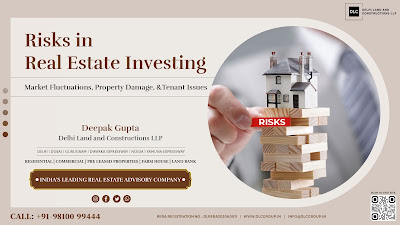Real estate investing can be a lucrative way to build wealth, but it is not without its risks. Investors must be aware of the various challenges that can impact their investments. Understanding and managing these risks is crucial for long-term success. This blog explores three significant risks in real estate investing: market fluctuations, property damage, and tenant issues.
 |
| Risks in Real Estate Investing |
Market Fluctuations
Market fluctuations are one of the most significant risks in real estate investing. These fluctuations can be caused by various factors, including economic conditions, interest rates, and changes in supply and demand.
- Economics Conditions: The broader economy plays a crucial role in real estate market dynamics. During economic downturns, property values may decline, and rental incomes can decrease due to higher unemployment rates and reduced consumer spending. Conversely, during economic booms, property values and rental incomes typically rise.
- Interest Rates: Interest rates directly impact the cost of borrowing money. When interest rates rise, mortgage payments become more expensive, which can reduce the affordability of buying properties. Higher interest rates can also deter potential buyers, leading to a slowdown in the real estate market. On the other hand, lower interest rates make borrowing cheaper, often leading to increased demand and higher property prices.
- Supply and Demand: The balance between supply and demand significantly affects real estate prices. An oversupply of properties can lead to decreased property values and rental incomes. Conversely, a high demand with limited supply can drive prices up, benefiting property owners. Factors influencing supply and demand include population growth, employment opportunities, and local economic conditions.
Mitigation Strategies:
- Diversification: Invest in different types of properties and geographic locations to spread risk.
- Research: Stay informed about economic trends and market conditions.
- Long-term Perspective: Real estate is generally a long-term investment. Short-term market fluctuations often balance out over time.
Property Damage
Property damage is another critical risk that real estate investors face. Damage can occur due to natural disasters, accidents, or wear and tear.
- Natural Disasters: Properties are vulnerable to natural disasters such as earthquakes, floods, hurricanes, and wildfires. These events can cause significant damage, leading to costly repairs and potential loss of rental income.
- Accidents: Accidental damage can occur from events like fires, plumbing failures, or electrical issues. Such incidents can render a property uninhabitable, requiring immediate repairs and temporary relocation of tenants.
- Wear and Tear: Over time, properties undergo wear and tear. Regular maintenance and repairs are necessary to keep the property in good condition and avoid more significant issues down the line. Neglecting maintenance can lead to severe damage and decreased property value.
Mitigation Strategies:
- Insurance: Ensure comprehensive property insurance coverage, including natural disaster protection.
- Regular Maintenance: Implement a proactive maintenance schedule to address wear and tear issues promptly.
- Emergency Fund: Maintain a reserve fund to cover unexpected repair costs.
Tenant Issues
Dealing with tenants is an integral part of real estate investing, but it comes with its own set of risks. Tenant issues can affect rental income, property condition, and overall investment returns.
- Non-Payment of Rent: One of the most common tenant issues is non-payment or late payment of rent. This can disrupt cash flow and make it challenging to cover mortgage payments and property expenses.
- Property Damage: Some tenants may cause damage to the property, either intentionally or through negligence. This can lead to costly repairs and reduce the property’s value.
- Legal Disputes: Disputes with tenants can arise over lease terms, security deposits, property conditions, and eviction processes. Legal disputes can be time-consuming and expensive to resolve.
- Vacancy: Periods of vacancy between tenants can result in a loss of rental income. Extended vacancies can significantly impact cash flow and overall returns.
Mitigation Strategies:
- Thorough Screening: Conduct comprehensive background checks and screenings to select reliable tenants.
- Clear Lease Agreements: Use detailed lease agreements to outline tenant responsibilities and terms.
- Property Management: Consider hiring a professional property management company to handle tenant issues and property maintenance.
- Legal Knowledge: Familiarize yourself with local landlord-tenant laws to handle disputes effectively.
Conclusion
Real estate investing offers significant opportunities for wealth creation, but it is essential to recognize and manage the associated risks. Market fluctuations, property damage, and tenant issues are among the most common challenges investors face. By understanding these risks and implementing effective mitigation strategies, investors can enhance their chances of success and protect their investments.
Diversification, thorough research, and maintaining a long-term perspective are key to navigating market fluctuations. Ensuring comprehensive insurance coverage, conducting regular maintenance, and having an emergency fund can help mitigate the impact of property damage. Finally, careful tenant screening, clear lease agreements, professional property management, and knowledge of legal regulations are crucial for managing tenant-related risks.
By taking proactive steps to address these risks, real estate investors can build a resilient portfolio capable of withstanding challenges and delivering sustainable returns over time.
No comments:
Post a Comment